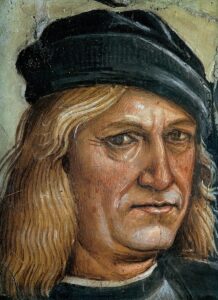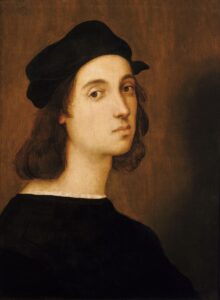The Pinacoteca comunale [Municipal art gallery] is housed in the sixteenth century Palazzo Vitelli alla Cannoniera, built between 1521 and 1543 to celebrate the marriage of the commander Alessandro Vitelli and his wife Angela Rossi of the Counts of San Secondo Parmense. As a result of various transfers of ownership, in the twentieth century the building was bought by the antique dealer Elia Volpi who donated it to the city in 1912, after having restored it and set up the art gallery and civic library.
The understated Renaissance architecture of the building is enriched on the garden-facing façade with an elegant etched graffiti decoration carried out by Cristofano Gherardi from Sansepolcro, known as Doceno, likely from a design by Giorgio Vasari. Part of the decorative apparatus in the internal rooms was done by Gherardi himself, who, along with Nicola Filotesio, also known as Cola dell’Amatrice, was involved in the creation. The fresco decoration, mostly of a profane theme, underlines the cultural interests and the cautious patronage of the Vitelli family.
Divided into twenty six rooms, to which further exhibition spaces are added for temporary exhibitions, the Pinacoteca comunale houses works of art from the fourteenth to the twentieth century, many of them bought after 1860 following the suppression of ecclesiastical institutions and when they became state property of artistic heritage. The rich collection bears witness to the artistic vitality that during the centuries has characterised Città di Castello, at the centre of an important route of communication and cultural exchange between various areas, such as Tuscany, Umbria and Marche. Amongst the foreign artists featured are Spinello Aretino, Antonio Vivarini, Lorenzo Ghiberti, Domenico Ghirlandaio, Luca Signorelli, Andrea Della Robbia, Raffaello, Raffaellino del Colle, Pomarancio and Santi di Tito. The Pinacoteca preserves precious furniture originating from churches and public convents, and amongst which we need to particularly mention the group of Gothic stalls, with engraved and decorated inlays, credited to the workshop of the most well-known Florentine carpenter of the early fifteenth century, Manno di Benincasa Mannucci, the cupboard of the vestry signed and dated 1501 by Antonio Bencivenni and the large engraved, golden coffin, that kept the body of the Blessed Margherita.
In the spaces opened in 2006 four important contemporary art donations are housed: the collection of plaster casts by the Tifernate sculptor Elmo Palazzi (1871-1915), a collection of bronzes created by Bruno Bartoccini from Citerna (1910- 2001), the Giorgio Ascani donation (1926-2008), in Nuvolo art, made up of fifteen works of art by the artist and donated to the Città di Castello council by his family in 2012, and the Ruggieri collection, donated in 1986, that contains about twenty pictures by some of the most significant Italian artists from the twentieth century such as De Chirico, Mafai, De Pisis, Dottori e Carrà.


(*) With the occasion of the exhibition “Raffaello giovane a Città di Castello e il suo sguardo”, curated by Laura Terza and Marica Mercalli (30.10.2021-9.01.2022), a new itinerary on the main floor of museum has been opened dedicated to the four works – Pala Baronci, Gonfalone della Santissima Trinità, Crocifissione Mond and Sposalizio della Vergine – of Raffaello Sanzio’s tifernate years (1499-1504). This museum itinerary has also been dedicated to the distant dialogue between Raffaello and Luca Signorelli, who left important paintings in Città di Castello such as
La Pala con il Martirio di San Sebastiano.
These two important artists of the Italian Renaissance never actually met in person, but it became a possibility five hundred years later in the Città di Castello’s Pinacoteca, where Raffaello’s Gonfalone della Santissima Trinità interacts for the first time vis-à-vis with Luca Signorelli’s Martirio di San Sebastiano.
On 10 December 1500 Raffaello signs the contract in Città di Castello for what is considered his first tifernate work.
On the document Raffaello is named Magister Rafael. Raffaello, together with “the native of the Marches” artist Evangelista da Pian di Meleto (Raffaello’s father’s workshop right-hand man), commit themselves with Andrea Baronci (a wool merchant and plenipotentiary of the Vitelli Family) to the Vitelli’s Chapel in Sant’Agostino. This work is The Incoronazione di San Nicola da Tolentino. This impressive table, almost 4 meters high, was ruined by the 1789 earthquake and was divided into fragments now stored at the Pinacoteca Tosio Martinengo of Brescia, at the Museo di Capodimonte of Naples and at the Louvre in Paris.
The Pala Baronci after Raffaello
After the 1789 earthquake, the Chiesa of Sant’Agostino and Raffaello’s table suffered extensive damage. The friars then decided to sell the painting that was reduced to fragments to
Pio VI with the condition that a copy would be placed in the Baronci Chapel once the restoration work was completed. The Roman painter Ermenegildo Costantini (1731-1791) was commissioned with the task. He created the work here exposed, smaller in size than the original to adapt it to the new measurements of the Chapel. The virtual reconstruction of the Table is under the care of the Museum Galilei
In this room the impossible encounter between Signorelli and Raffaello occurs. The Pala del San Sebastiano meets the Stendardo Processionale della Santissima Trinità, the only remaining Raffaello’s mobile work left in Umbria. The Gonfalone in the Sala della Contemplazione has a vis- à-vis dialogue with Luca Signorelli’s Martirio di San Sebastiano, created about 1498 for the Brozzi Chapel in San Domenico.
These two paintings are ideally connected through Raffaello’s look where he combined them in a drawing (now at the Oxford Ashmolean Museum), where Raffaello studies the pose of the God Creator of the Creation of Eve in the Gonfalone and copies the crossbow of the Martirio, seen fromthe rear.
(*) Testi adattati da “Raffaello giovane a Città di Castello e il suo sguardo. Visita virtuale” di Francesca Mavilla. Supervisione a cura di Francesca Mavilla e Marta Onali. Si ringrazia per la collaborazione Silvia Palazzi
The rise of the young Raffaello is rapid.
He receives commissions from supportive families and Allie’s of Vitelli in Città di Castello.
The commission of the Crocifissione in San Domenico is traced back to the powerful family of Domenico Gavari. Now the young artist openly dialogues with his main contemporary painters such as Perugino and Pintoricchio, being confrontational with them in a competition to elaborate their models, developed with brilliant inventive maturity.
The Crocifissione Gavari after Raffaello
The family Gualterotti of Città di Castello (who purchased the Gavari Chapel) sold the painting to the Cardinal Fesch on 1808 for the price of 2500 scudi. After several changes of ownership, the piece was sent to Ludwig Mond and on 1924 belonged to the London National Gallery ( after the bequest of its latest owner).
Raffaello’s artistic heritage and his creative genius will leave an indelible mark on Città di Castello for many centuries. In the Sala della Crocifissione Gavari are exhibited also two paintings by Francesco Tifernate.
Before his departure from Umbria towards Florence in 1504, Raffaello leaves The Sposalizio della Vergine on the altar of Filippo Albizzini in San Francesco. The painting represents a turning pointin his career.
The approach of his work is compaired in a desired and close comparison with a similar subject that Pietro Perugino was painting for the Duomo of Perugia. The painting quickly turns out to be a paradigm of the classical style of the Renaissance, that places Raffaello into the history.
Lo Sposalizio after Raffaello
Lo Sposalizio will remain on the Albizzini altar until January 1798, when it was gifted to the General Giuseppe Lechi of Brescia (commander of the cisalpine troops) from the tifernate’s municipality. It will then pass hands to the Giacomo Sannazaro della Ripa “milanese” collection, then again to the Ospedale Maggiore Collection, and ultimately to the Pinacoteca of Brera in 1806 where it is still kept.
Raffaello giovane e Città di Castello, Città di Castello 1983;
F. F. Mancini, Palazzo Vitelli alla Cannoniera, voll. 1-2, Perugia 1987-1988;
R. Ferrazza, Palazzo Davanzati e le collezioni di Elia Volpi, Firenze 1994;
T. Henry, Gli esordi di Raffaello tra Urbino, Città di Castello e Perugia, catalogo della mostra Città di Castello, Palazzo Vitelli alla Cannoniera, 24 marzo – 11 giugno 2006, Perugia 2006;
C. Zappia, Il Novecento a Palazzo Vitelli alla Cannoniera, Città di Castello 2009;
T. Henry, Luca Signorelli a Città di Castello: la vita, l’opera e la scuola in alta valle del Tevere, Città di Castello 2013;
A. Delpriori, Prima e dopo Raffaello: Città di Castello e il Rinascimento, Perugia 2019.
Once at the museum, download the RIM Altotevere App and frame the QR codes placed along the route to access exclusive content.